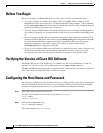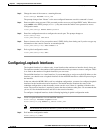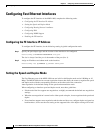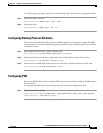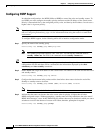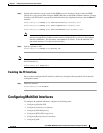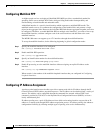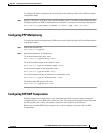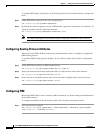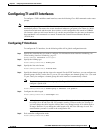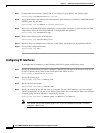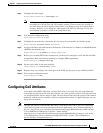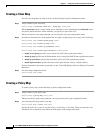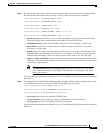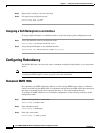
4-9
Cisco MWR 1900 Mobile Wireless Edge Router Software Configuration Guide
78-13983-04
Chapter 4 Configuring with the Command-Line Interface
Configuring Multilink Interfaces
To configure IP address assignment, do the following do the following while still in multilink interface
configuration mode:
Step 1 Specify an IP address, an address from a specific IP address pool, or an address from the Dynamic Host
Configuration Protocol (DHCP) mechanism to be returned to a remote peer connecting to this interface:
RPM-3(config-if)# peer default ip address {ip-address | dhcp | pool [pool-name]}
Configuring PPP Multiplexing
To enable and control the multiplexing of PPP frames, do the following while still in multilink interface
configuration mode:
Step 1 Enable PPP multiplexing:
RPM-3(config-if)# ppp mux
Step 2 Specify the parameters of multiplexing.
To set the maximum time delay, enter:
RPM-3(config-if)# ppp mux delay integer
To set the maximum length of the subframe, enter:
RPM-3(config-if)# ppp mux subframe length integer
To set maximum length of the superframe, enter:
RPM-3(config-if)# ppp mux frame integer
To set the maximum number of subframes in a superframe, enter:
RPM-3(config-if)# ppp mux subframe count integer
To set the default PPP protocol ID, enter:
RPM-3(config-if)# ppp mux pid integer
Configuring RTP/UDP Compression
Enabling compression on both ends of a low-bandwidth serial link can greatly reduce the network
overhead if there is a lot of RTP traffic on that slow link. This compression is beneficial especially when
the RTP payload size is small (for example, compressed audio payloads of 20-50 bytes).
Before you can enable RTP header compression, you must configure a serial line that uses PPP
encapsulation.




